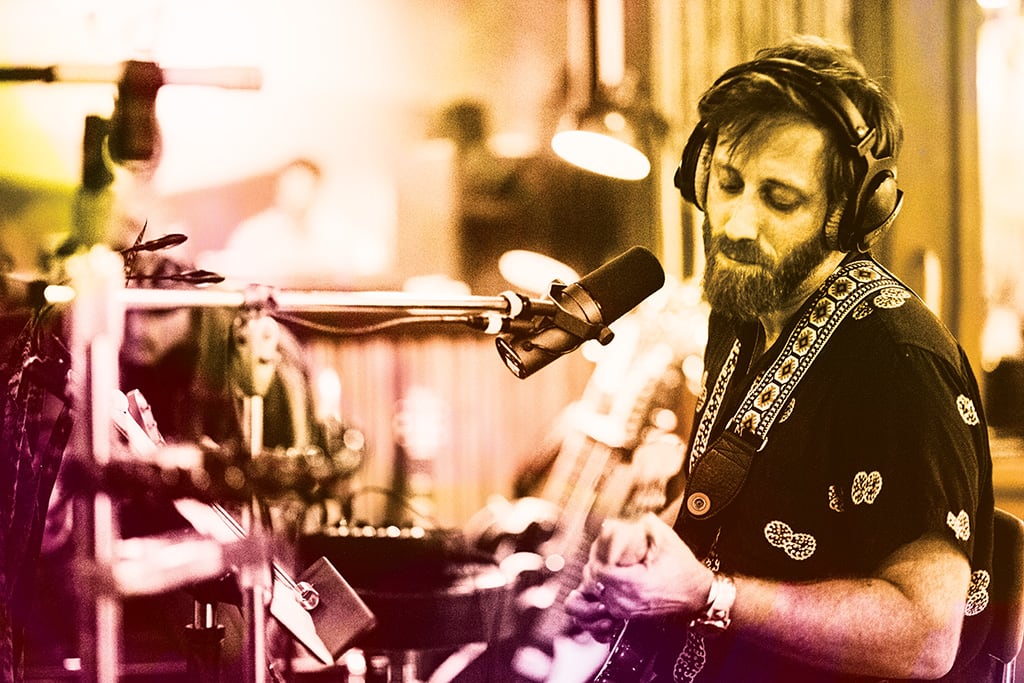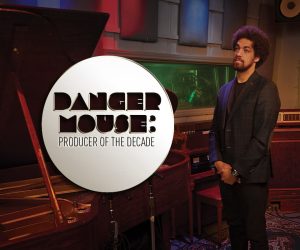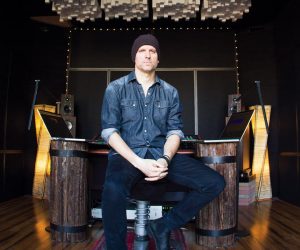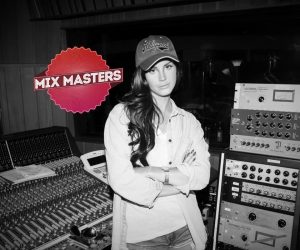
Auerbach Not at a Loss For a Song
With over 100 songs written and recorded during the making of the Black Keys frontman’s latest solo album, M Allen Parker developed a system to get the most out of Easy Eye Sound’s vintage gear.

Artist: Dan Auerbach
Album: Waiting on a Song
Photos: Alysse Gafkjen
Clearly the wait wasn’t long when working on Dan Auerbach’s Waiting on a Song. In all, 100 songs were written and recorded for the Black Keys frontman’s second solo album before being whittled down to the final 10.
“Dan used to write songs as part of the recording process,” elaborated co-producer and engineer M Allen Parker about the Black Keys’ process. “Pat [Carney] and he were writing the songs in the studio while they were making the record. However, in Nashville there’s a long tradition of guys going into a room with just an acoustic guitar and a little later coming out with the better part of a finished song. Dan wanted to write more in that traditional Nashville way, which he had never done before.”
He assembled a team of co-writers that included Nashville legends like John Prine, Pat McLaughlin, and David Ferguson at his Easy Eye Studios in Nashville and got into a rhythm of “he and some others writing songs on Monday, Tuesday and Wednesday,” explained Parker. “Then Thursday, Friday and Saturday we’d be recording and overdubbing. It would not be uncommon for us to track five or six songs on Thursday and Friday and then do overdubs on those songs on Saturday. The next Monday, we’d start again. By the time the album came out we had recorded over 100 songs, with most of them fully produced with backing vocals and a pretty good mix!”
The musical direction of his new album has a lot to do with Auerbach moving from Akron to Nashville in 2010, where he set up his own studio, Easy Eye Sound. Waiting On A Song is a celebration of Nashville-inspired country and 1970s soft rock, so he gathered the old guard of Nashville to help deliver on the premise. The all-star cast included famous guitarists Mark Knopfler, Duane Eddy, and Jerry Douglas, as well as older session musicians with impressive track records such as keyboardist Bobby Wood (Elvis, Garth Brooks), bassist Dave Roe (Johnny Cash), guitarist Russ Pahl (Don Williams), drummer Gene Chrisman (Elvis, Bobby Womack, Aretha Franklin), and many others.
They all would have felt right at home within the walls of Easy Eye Sound Studio, which is stuffed to the rafters with vintage studio gear, instruments and amps. However, even a jack of all trades and master of many like Auerbach — who’s also an active producer as well as a songwriter and musician — can’t do everything, so he’s long worked with a regular engineer at Easy Eye. In January 2016, Auerbach found his latest partner in crime: engineer and mixer M Allen Parker, who has a background in the very music that informs Waiting On A Song.
“Ocean Way Nashville is where I came up,” said Parker, who was a staff engineer there before going freelance in 2008 and has a credit list including Merle Haggard, Jerry Douglas, Sheryl Crow, Joe Walsh, Indigo Girls and Keith Urban. “I obviously did plenty of country sessions there, but working at a studio of that calibre exposed me to all kinds of sessions, engineers, and producers.
“A really great engineer named Collin Dupuis moved down here with Dan and helped him build his studio, as well as engineering many of the records Dan did here. When Collin became less available I connected with Dan and we sort of hit it off. After working together for six months or so he asked me to become chief engineer and studio manager. Dan has worked a lot with driven rock styles on all The Black Keys records, and I came up doing country music and styles centred around vocals and natural acoustic instruments. That combination really lent itself to what Dan wanted to do with his new record.”
EASY EYE SOUND
All sessions took place at Easy Eye, with Parker making good use of the classic gear there. “The main desk here is an old Spectrasonics which is from around 1972. We mix through that desk. There’s also an Altec 9300 console from the early ’70s, which has great mic pres. We used that a lot for recording. The big monitors here are Equators, which have DSP in them. I’m not usually a fan of DSP but the room is funky in shape — long and narrow — so it allows us to get the monitors working in this room. The smaller, mid-sized monitors were made for Dan years ago by Norman Druce of Atomic Instruments.
“The studio has a fairly large live room, about 30 by 45 feet with a ceiling about 12 feet high. The space is pretty dead, and there’s a Studio B, which now functions like a booth. We record vocals, acoustic guitar and acoustic bass in there, but for the rest it’s pretty much everyone on the floor. We’ll put some baffles around the drums, but there will always be some bleed. That doesn’t really matter to us, because it’s like those classic records from the 1970s where bleed is what glues them together.
“The design of the studio is pretty unique among modern studios, and reminiscent of studios like Hitsville in Detroit or Sam Phillips Recording in Memphis, in that it has a certain sound and there’s an established way of doing things that allows us to work really quickly. Even when we’re mixing, if Dan decides he wants an additional drum part in the bridge, we’re ready to track drums, or any other instrument, in three or four minutes. The studio is designed with production in mind and to make it easy to get ideas down as they happen.”

DYNAMIC ENSEMBLE
Different sets of musicians would come in during the sessions, but there were a number of mainstays who played and/or sang on most songs: bassist David Roe and steel guitarist Russ Pahl played on all the tracks. Matt Combs played live strings, while Bobby Woods played keyboards. Jeffrey Clemens played drums and percussion on most tracks, but the throne was occasionally kept warm by Kenny Malone or Gene Chrisman. A few less typical instruments populate the list: glockenspiel, chimes, mandola, flute, vibraphone, marimba and sitar, mostly played by one of the aforementioned. Plus there are horns, and several backing singers. In true polymath fashion, Auerbach sings, and plays electric and acoustic guitar, bass, mellotron, baritone guitar, and percussion, and also produced and mixed alongside Parker.
It’s a rich palette of musicians and instruments, and M Allen Parker recorded them with an unusual reliance on vintage dynamic mics. “For the recordings of the basic tracks we had everyone in the room at the same time, and for most of the time this was electric bass, keyboards (either a piano or a Wurlitzer), drums, electric guitar, and two acoustic guitars isolated in the other rooms. I often recorded Dan’s voice as he played acoustic, usually with a vintage (ie. American-made) Shure SM7 going into the Altec console, and using an Empirical Labs DerrEsser and Universal Audio 176 compressor, before going to Pro Tools. The SM7 sounds amazingly good, and has good separation from the guitar. The UA 176 is one of the greatest compressors ever, especially on vocals. We also have the Retro 176, which I use quite a bit, but there’s nothing like the old 176. Sometimes I also used a Chandler EQ on the way in, to take out some bottom end and do a high pass before it hit the compressor.
DYNAMIC: MIKING GUITARS
“I also mostly used a dynamic on his acoustic guitar. It depended on the day, but it tended to be something old like the AKG D19C or a Sennheiser MD408 or an EV RE15. Those are not thought of as being acoustic guitar mics, but they get me a really focused sound. They don’t have the super top end of tube and condenser mics, and they also don’t pick up too much bottom, something which you would take out with big strumming guitar anyway. Instead they give you a mid-range excitement which is really helpful in a track. Overall these mics do a lot of work for you because they are not crazily responsive so you don’t have to compress them much, if at all. They also add character, which is why I use different mics for different flavours.
“I put an RCA KU-3A on Jerry Douglas’ Dobro because it tames some of the aggressiveness. It has a little honk to it, but I liked that for the tracks we were cutting. I used a Neumann KM54 on some of the shinier acoustics, because they have a bit more fidelity and are very open sounding. The electric guitars were all recorded from real amplifiers using old dynamic mics like the Shure SM56 or EV-666. I will often listen to two options on an amp and pick the one that seems to works the best. The electric bass went through an old passive DI with a big UTC transformer, and some compression from a Vari-Mu-style compressor. I also have a mic on the bass amp, and on that I have the Highland Dynamic BG2, which is another compressor I love. I had the BG2 on Pat McLaughlin’s acoustic guitar or mandolin. By the way, Mark Knopfler’s electric guitar was recorded in London at his own studio. We sent him the song, Shine On Me, and he came up with the perfect rhythm part.
By the time the album came out we had recorded over 100 songs, with most of them fully produced with backing vocals and a pretty good mix!

KEEP IT SIMPLE: MIKING DRUMS
“The drums are recorded in a really simple way. I often just use two or three mics, the AKG D36 on the kick, a Sony C37a or an SM7 as a mono kit mic, and a mono overhead, usually a Coles ribbon. I’ll also put a Shure SM57 on the snare top, and the toms will have an EV RE15 or SM57, and the same with the hi-hat. Really simple mics. I place the mono kit mic somewhere between the kick and the ride cymbal, and tweak it from song to song. We used a lot of the same drums and a lot of the same microphones, but the kit sounds different almost every day, so I am always moving the kit mic a foot here or six inches there, to see if I can pick up certain parts of the drums better, in a way that’s the most appropriate for the song. In Never In My Wildest Dreams I only used that kit mic! On the way in I used a vintage Altec 436 modded like the EMI Altec 61010B compressor, the one that Chandler now has as a preset on its RS124 compressor.
“We usually recorded the drums with the other musicians in the room. Jeffrey Clemens is from New Orleans, and doesn’t really play that hard, which allows me to over-compress him. A lot of that I did on the way in, so he can hear it in his headphones and play into that, helping him not to overplay. Cherrybomb is a good example. The drums have a lot of power, but he’s not playing them all that hard. I really hit it hard with the Altec compressor, which is kind of slow, and that’s most of the drum sound. That worked for maybe half the songs. Living’ In Sin is also an example of drums with a great thump and kick, that are more the result of him interacting with the compressor than beating the heck out of the drums. Jeffrey playing the drums not too hard also enabled us to keep the bleed at reasonable levels.
BOLD BRASS: THE OVERDUBS
“For overdubs, I recorded Pat McLaughlin’s backing vocals with an SM7, sometimes an RE15, and then went through the Altec console and a Retro Instruments 176. The three girls, Ashley Wilcoxson, Heather Rigdon, and Leisa Hans usually sang on a Neumann U67, all together and going through a UA176. I also used the U67 on the melodic percussion, fairly indirectly because glockenspiel and vibes and chimes can get aggressive-sounding if you have the mic right up on them. To me, they sit better in the mix when they are recorded from 10 or 12 feet away. The sitar was an electric sitar, so it was run through an amp and recorded like an electric guitar. The horns on Wildest Dreams were recorded at Electric Lady in New York, but the rest of the horns we recorded in Nashville were picked up with dynamic mics like Shure SM7 and SM56 on trumpets and trombones, and the EV-667 on baritone sax. Occasionally I’d use an RCA KU3A. Everything went through the Altec 9300 console, and I’d tap the horns a little with a Calrec AM6/17A compressor.”

SPECTRASONICS MIX GLUE
Throughout the recording process for Waiting On A Song, Parker was continually rough mixing the songs in the box, sometimes with help from Auerbach, until the moment came to whittle the 100+ songs down to something more manageable. Parker: “Dan is the producer, and when he makes decisions he liaises with some people he really trusts, and some of the older songwriters that were around. We got the 100 songs down to 30 pretty easily, and once we got it down to 15-18 songs, we started mixing them properly.
“I probably carried the mixing from a technical standpoint, but mixing is a balance of technical and creative skillsets. As an engineer/mixer you can sometimes get too focused on making sure everything sounds ‘right’ and forget that little creative touches are often what make a mix really stand out. Sometimes I’d get in the weeds with stuff that may or may not matter in the end, but Dan always seems to know what’s important and make sure we don’t lose sight of that. I’ve never worked with someone who has that much creativity during a mix, it’s incredible. He’s happy for me to try something if I have an idea I want to chase, so there’s give and take between us. It’s a good balance.”
Parker and Auerbach had a template for the mixes, which included laying the sessions out a certain way, and sending 12 outputs from Pro Tools through the Spectrasonics desk. Parker: “I use 12 inputs on the console and then other outputs to feed analogue reverbs and delays, which would come back into the console as well. These are all effects that added a classic tonality that was in harmony with the general direction of the album. We have some old plates, like the Echoplate 1 and 2, EMT 140, as well as an AKG BX10 spring reverb, Roland RE-150 Space Echo, and an Ampex 350 tape recorder for tape slap, which seems outrageous but sounds really great. The template was more about the workflow than the sounds. We didn’t pull in loads of plug-in presets. We always started from the same place and then started shaping sounds for each song.
“I also did all the volume rides in Pro Tools, and got pretty involved with that, making sure all the details can be heard, without them taking over. Country-influenced music is always about the vocal, and I think this record is also about the lyrics and the melody, so I spent a lot of time riding vocals and making sure they were right. We weren’t really moving faders a lot on the Spectrasonics console, it functioned more like a summing box. We used a little of the EQ and the amps sound so good that if you hit it hard, it glues everything together in a special way. It definitely has some compression when you drive it just right, though you don’t want to beat it up, because if you’re not paying attention your mix will sound smaller.”
MASTERING THAT ’70s SOUND
“Richard Dodd mastered this album,” said Parker. “He did a really great job getting it really loud and still making sure it sounds musical. It feels like a better version of our mixes, which is what you always hope will happen. The mix of Wildest Dreams is probably more dynamic than most songs on the record. If you look at some of the other songs, the waveform ends up being pretty black by the time Richard gets it! But if it sounds good then who cares?
“We simply wanted it to sound great, and the whole ’70s feel and vibe of the album emerged organically, and was not by design. We occasionally referenced stuff from the ’70s, but we were not AB-ing things. If Dan said: ‘Man, would it be cool if this sounds a bit more like The Band,’ I knew what he meant. I didn’t have to go back and play something by The Band. Moreover, because we had all these great musicians come in, many of whom played on these old records, it was always quite naturally going to sound like that, even when we brought our modern approach to it.”
















RESPONSES